
Red Ryder is a Western comic strip created by Stephen Slesinger and artist Fred Harman which served as the basis for a wide array of character merchandising. Syndicated by Newspaper Enterprise Association, the strip ran from Sunday, November 6, 1938, through 1965.

All-American Comics is a comics anthology and the flagship title of comic book publisher All-American Publications, one of the forerunners of DC Comics. It ran for 102 issues from 1939 to 1948. Characters created for the title, including Green Lantern, the Atom, the Red Tornado, Doctor Mid-Nite, and Sargon the Sorcerer, later became mainstays of the DC Comics line.
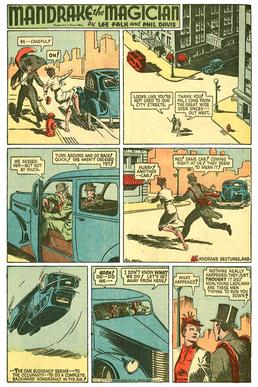
Mandrake the Magician is a syndicated newspaper comic strip, created by Lee Falk before he created The Phantom. Mandrake began publication on June 11, 1934. Phil Davis soon took over as the strip's illustrator, while Falk continued to script. The strip was distributed by King Features Syndicate.
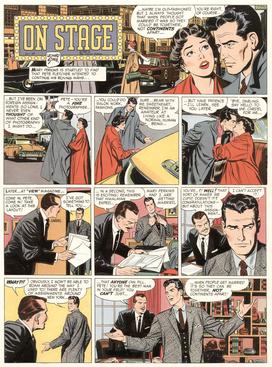
Mary Perkins, On Stage is an American newspaper comic strip by Leonard Starr for the Chicago Tribune-New York News Syndicate. It ran from February 10, 1957, to September 9, 1979, with the switch to the longer title in 1961. Some papers carried the strip under the shortened title Mary Perkins.

A topper in comic strip parlance is a small secondary strip seen along with a larger Sunday strip. In the 1920s and 1930s, leading cartoonists were given full pages in the Sunday comics sections, allowing them to add smaller strips and single-panel cartoons to their page.

Tales of the Green Beret is an American comic strip created by the nonfiction author Robin Moore and artist Joe Kubert. Published in the 1960s, its Vietnam War setting was concurrent with the controversial real-life conflict.
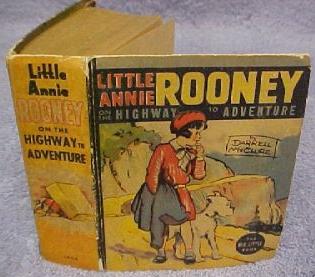
The Big Little Books, first published during 1932 by the Whitman Publishing Company of Racine, Wisconsin, were small, compact books designed with a captioned illustration opposite each page of text. Other publishers, notably Saalfield, adopted this format after Whitman achieved success with its early titles, priced initially at 10¢ each, later rising to 15¢.
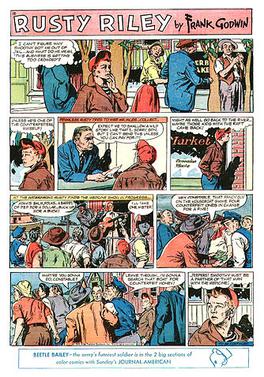
Rusty Riley is an American adventure comic strip which ran from 1948 to 1959. It was created and drawn by Frank Godwin for King Features.

Fred Charles Harman II was an American cartoonist, best known for his popular Red Ryder comic strip, which he drew for 25 years, reaching 40 million readers through 750 newspapers. Harman sometimes used the pseudonym Ted Horn.

Gene Carr was an American cartoonist.
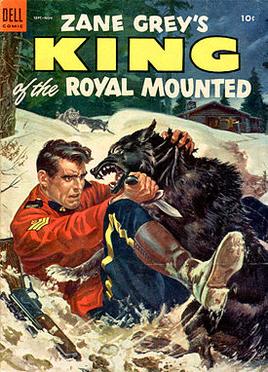
Stephen Slesinger was an American radio, television and film producer, and creator of comic strip characters. From 1923 to 1953, he created, produced, published, developed, licensed or represented several popular literary characters of the 1920s, 1930s and 1940s.

Dan Dunn is a fictional detective created by Norman W. Marsh. He first appeared in Detective Dan: Secret Operative No. 48, a proto-comic book from 1933, produced by Humor Publishing. He subsequently appeared in newspaper comic strips from 1933 to 1943.
King of the Royal Mounted is an American comics series which debuted February 17, 1935 by Stephen Slesinger, based on popular Western writer Zane Grey's byline and marketed as Zane Grey's King of the Royal Mounted. The series' protagonist is Dave King, a Canadian Mountie who always gets his man and who, over the course of the series, is promoted from Corporal to Sergeant. King has appeared in newspaper strips, comics, Big Little Books, and other ancillary items.

Magazine Enterprises was an American comic book company lasting from 1943 to 1958, which published primarily Western, humor, crime, adventure, and children's comics, with virtually no superheroes. It was founded by Vin Sullivan, an editor at Columbia Comics and before that the editor at National Allied Publications, the future DC Comics.

Freckles and his Friends is an American comic strip set in the peaceful small town of Shadyside where young Freckles McGoosey and his friends lived. Although the long-running strip, created by Merrill Blosser, is remembered for its continuing storyline involving a group of teenagers, it originally featured a child at the age of six or seven in gag-a-day situations.

James Robert Williams was a Canadian cartoonist who signed his work J. R. Williams. He was best known for his long-run daily syndicated panel Out Our Way. As noted by Coulton Waugh in his 1947 book The Comics, anecdotal evidence indicated that more Williams' cartoons were clipped and saved than were other newspaper comics. A newspaper promotion of 1930 compared him to poets Eugene Field and James Whitcomb Riley.

Out Our Way was an American single-panel comic strip series by Canadian-American comic strip artist J. R. Williams. Distributed by Newspaper Enterprise Association, the cartoon series was noted for its depiction of American rural life and the various activities and regular routines of families in small towns. The panel introduced a cast of continuing characters, including the cowboy Curly and ranch bookkeeper Wes. Out Our Way ran from 1922 to 1977, at its peak appearing in more than 700 newspapers.
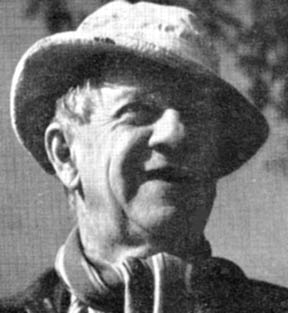
Clare Victor Dwiggins was an American cartoonist who signed his work Dwig. Dwiggins created a number of comic strips and single-panel cartoons for various American newspapers and newspaper syndicates from 1897 until 1945, including his best-known strip, the long-running School Days.

Western comics is a comics genre usually depicting the American Old West frontier and typically set during the late nineteenth century. The term is generally associated with an American comic books genre published from the late 1940s through the 1950s. Western comics of the period typically featured dramatic scripts about cowboys, gunfighters, lawmen, bounty hunters, outlaws, and Native Americans. Accompanying artwork depicted a rural America populated with such iconic images as guns, cowboy hats, vests, horses, saloons, ranches, and deserts, contemporaneous with the setting.
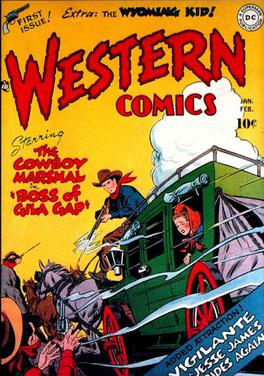
Western Comics is a Western comic book series that was published by DC Comics. DC's longest-running Western title, it published 85 issues from 1948 to 1961. Western Comics was an anthology series, featuring such characters as the wandering cowboy the Wyoming Kid, the Native American lawman Pow Wow Smith, the Cowboy Marshal, Jim Sawyer, showman Rodeo Rick, and Matt Savage, Trail Boss. The masked Vigilante Greg Saunders appeared in the first four issues of the title, but was soon replaced by itinerant fix-it man Nighthawk.


















